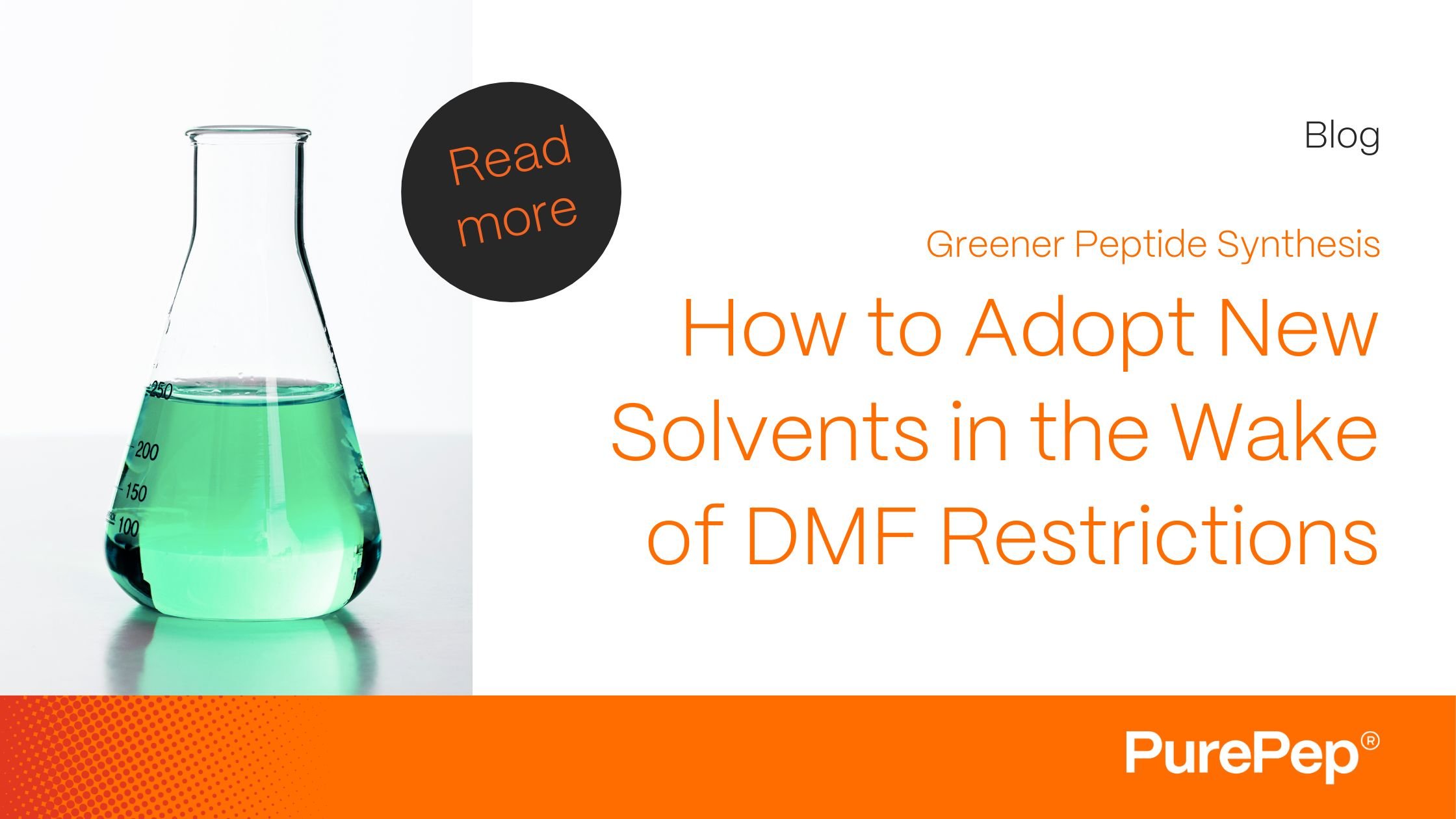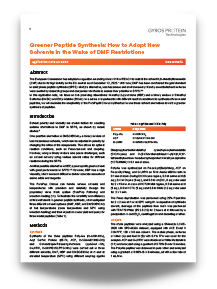Greener Peptide Synthesis: How to Adopt New Solvents in the Wake of DMF Restrictions

Due to new EU regulations, Dimethylformamide (DMF), a commonly used solvent in solid-phase peptide synthesis (SPPS), is now restricted in Europe.1 This change, effective from December 12, 2023, presents challenges and opportunities for peptide manufacturers.
DMF and greener SPPS
The reason for the European regulations to DMF restrictions arises from safety concerns. DMF is a reproduction-toxic solvent and is listed as a CMR agent (carcinogenic, mutagenic, or toxic for reproduction). How does that relate to greener peptide synthesis? A look into the 12 principles of green chemistry (Figure 1) sheds light as these principles guide the path toward greener solid-phase peptide synthesis (GSPPS).2, 3
Figure 1. The 12 principles of green chemistry by Paul Anastas and John Warner
Principles 3, 4, 5, and 12 are safety-related aspects and as such crucial for evaluating the environmental impact of a chemical substance. Therefore, regulatory restrictions on hazardous solvents like DMF, which are vital for SPPS in research and commercial production, have accelerated the search for eco-friendly alternatives. This will minimize reliance on hazardous solvents and reduce their ecological impact.
New solvents in peptide synthesis
In the quest for alternative solvents to DMF in SPPS, solvent polarity and viscosity have been identified as crucial factors, as recent studies show.3
- One promising alternative is DMSO/EtOAc, a binary mixture of less hazardous solvents, which can be adjusted in polarity for optimal reaction conditions by changing the ratios of the components.4
- Another possible alternative is NBP, a polar aprotic green solvent with good performance in SPPS.5,6
 Our recent application note highlights that instrument design and flexibility are vital to adopting these new solvents and solvent mixtures to obtain the best possible purity results for peptides with different properties and synthesis challenges. Based on three model peptides, we could show how to get similar or even superior results with the PurePep® Chorus and binary mixtures of DMSO/EtOAc. NBP also works well but is limited to higher temperatures. The Symphony® X parallel peptide synthesizer has also successfully been used with binary mixtures.2
Our recent application note highlights that instrument design and flexibility are vital to adopting these new solvents and solvent mixtures to obtain the best possible purity results for peptides with different properties and synthesis challenges. Based on three model peptides, we could show how to get similar or even superior results with the PurePep® Chorus and binary mixtures of DMSO/EtOAc. NBP also works well but is limited to higher temperatures. The Symphony® X parallel peptide synthesizer has also successfully been used with binary mixtures.2
A holistic approach for truly green peptides
Our studies show that high crude purities can be obtained when the right DMF-free SPPS strategy is in place. However, more purity might be needed for the target application, and a purification step becomes necessary. This is where another contributor to the ecological impact: High-pressure liquid chromatography using Acetonitrile (MeCN)/Water mixtures as eluents. First, MeCN is also classified as a moderate toxic solvent (principle 5), and second, the amount of solvents used and waste generated is massive at the R&D scale and even more on the commercial scale (Principle 1: Prevent Waste).
Consequently, a holistic approach to improve the ecological impact of peptide manufacturing must consider both synthesis and purification. A potential solution is catch-and-release purification as an alternative to HPLC because it offers a vast potential to minimize solvent use and waste generation.3
It's important to note, that switching to less hazardous and less solvent-consuming procedures is a big step forward in greener peptide production. Yet, there are more principles to follow, and more innovation is needed to improve the ecological impact of the process with regard to for example improved atom economy (Principle 2) and use of derivatives in Fmoc-chemistry (Principle 8).
Conclusion
The peptide industry is adapting quickly to comply with new EU regulations that restrict the use of DMF, and with that, "green" innovation is emerging as the cornerstone of solid-phase peptide synthesis. There is promising evidence that new DMF alternatives like DMSO/EtOAc or NBPP will be effective, and flexible instrument platforms like the PurePep Chorus and Symphony X are already adopting these new solvents and solvent mixtures in academic and industry environments to accommodate these changes. Additionally, orthogonal purification like PurePep EasyClean can help improve the ecological impact of the entire production workflow covering synthesis and purification.
Literature
[1] COMMISSION REGULATION (EU) 2021/2030 of 19 November 2021
[2] https://www.acs.org/greenchemistry/principles/12-principles-of-green-chemistry.html
[3] L. Ferrazzano et al., Green Chem 2022, 24, p. 975
[4] V. Martin et al., Green Chem 2021, 23, p. 3295
[5] S. Jadhav et al., Green Chem 2021, 23, p. 3312
[6] J. Lopez et al., Org Process Res. Dev. 2018, 22, p. 494
[7] A. Kumar et al., ChemSusChem 2020, 13, p. 5288
